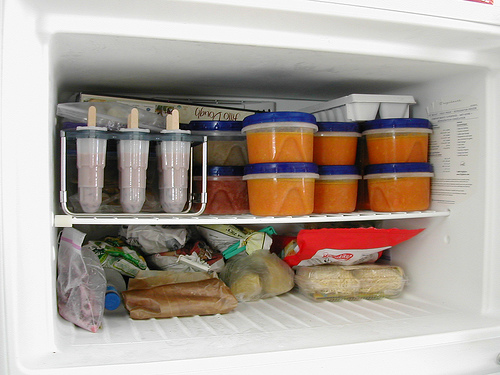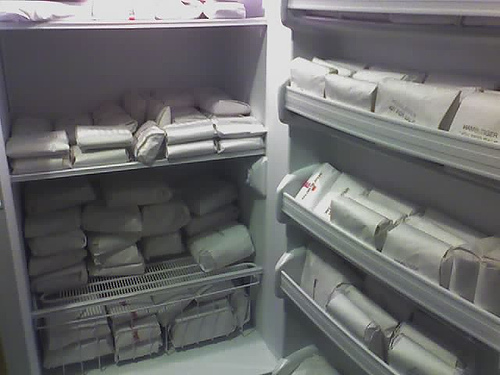All about: Properly storing meat in the freezer

One great way to combat the high price of meat is to buy it in mega-packs and freeze it for later. The Safeway where I shop sells "Extreme Value Packs" with pretty good cuts of meat for at least half the cost per pound of buying those same cuts in a smaller package. The down side being that you have to purchase several pounds of (say) ribeye steak at once. Unless you have a large family or are hosting a big party, you will probably need to freeze a lot of it in order to avoid letting it go to waste.

Image courtesy Flickr/framboise
Sidebar: Technically meat is good for several days past the "sell by" date on the package. However, I have found that once you open the package, the remaining meat starts to get funky after 24 hours. 48 hours later, even if I rewrap it well and I know it's being stored at the proper temperature (38 degrees) there is noticeable discoloration and an "off" smell.
However, I do tend to be fussier about raw meat than a lot of other people. In theory you could buy a value pack of steaks, eat one a night for four nights, and be fine.

Image courtesy Flickr/thejesse
What happens in the freezer?
As you know, water expands when it freezes. This causes a problem when you freeze meat and produce, because the expanding water ruptures the walls of the cells that contain it. If you don't freeze things properly, this causes a significant degradation in the quality of your frozen food.
Not all parts of your freezer are created equal. The shelf on the door is constantly being exposed to fluctuating temperatures every time you open the freezer. These frequent freeze-thaw cycles can damage frozen food even more. Thus, you should never put anything in the door shelf that you care about.
When freezing meat, be sure to stack it in the back of your freezer, where the temperatures are most stable. (Just don't forget about it back there!)

Image courtesy Flickr/~Mandie~
What about a power outage?
I live in a rural area which experiences frequent power outages. As long as you do not open the door of your freezer, the food inside will probably be safe for at least 24 hours.
When the power comes back on, check the temperature inside your freezer. If it is under 40 degrees and still has ice crystals, then your food is safe. If it has been over 40 degrees for more than 2 hours, throw it away.

Image courtesy Flickr/stevendepolo
What is freezer burn? And how to prevent it?
"Freezer burn" is harmless, but makes your food taste really bad. This is what happens when the moisture in the outermost layers of the food evaporates into the freezer in a process called "sublimation." This process of drying out leaves a layer of frost on the surface of the meat, which may also turn an unappetizing shade of gray.
Freezer burn happens when frozen meat is exposed to air. If you have ever brought home a package of meat from the store and stuck it straight into the freezer, this is a guaranteed recipe for freezer burn. There is no cure for freezer burn, beyond cutting off and discarding the affected areas.
To prevent freezer burn, wrap everything in specially designed freezer bags, or a double layer of plastic wrap, and rotate your stock often. Even the most carefully-wrapped meat will succumb to freezer burn eventually if you leave it in there long enough.

Image courtesy Flickr/Another Pint Please...
How to wrap meat for freezing
Your main goal is to protect the meat from the air. The Kitchn recommends wrapping it tightly in plastic wrap or freezer paper, and then giving it a second layer of aluminum foil or in a freezer zip-top bag with as much air removed as possible.
Be sure to write a date on the package, to help ensure that nothing gets overlooked and left in the freezer for too long. And a short description, if the contents aren't obvious at a glance. (No one likes mystery meat!)
Thawing frozen meat
At the other end of the cycle, it's important to thaw your frozen meat correctly. Don't just leave it out on the counter. The outer portion of the meat will thaw long before the center, and breed bacteria. Thaw it in a bowl in your refrigerator.
If you need to thaw something quickly, put it (still wrapped) in a bowl in the sink and run tepid water over it. This will thaw most cuts of meat in about 15-30 minutes. Be sure to either cook them right away, or put them straight into the fridge.
Main image courtesy Flickr/sporkist

2 comments